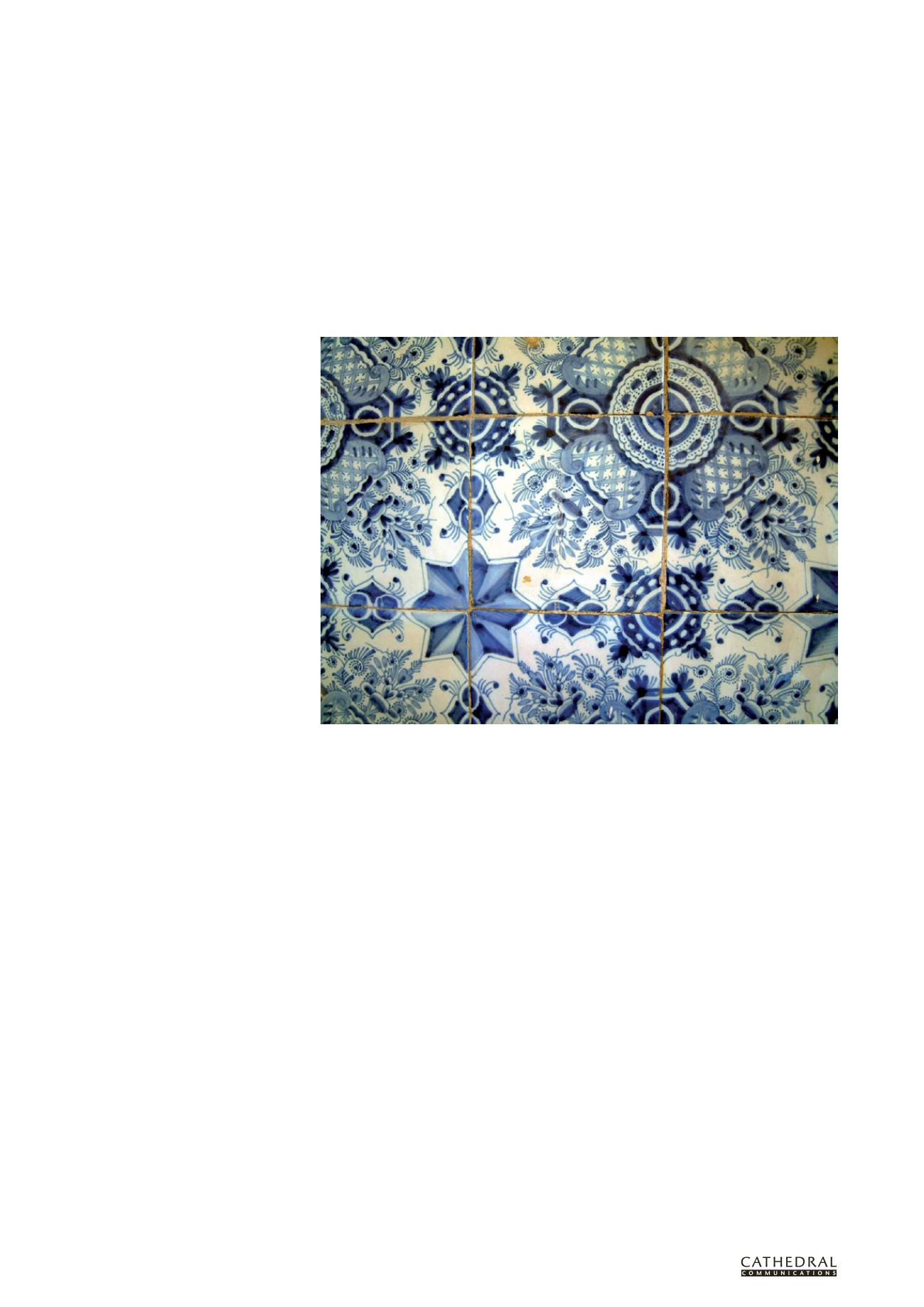

1 7 6
T H E B U I L D I N G C O N S E R VAT I O N D I R E C T O R Y 2 0 1 5
T W E N T Y S E C O N D E D I T I O N
INTER IORS
5
TILE WORK OF THE 17th and
18th CENTURIES
Migration of techniques and styles
Lesley Durbin
T
HE HISTORY
of what we have largely
come to recognise as the 17th- and
18th-century tile work of northern
Europe is a fascinating trail of migrating
communities and craft techniques.
Glazed ceramic tile- and brick-making
is an ancient art first found in Egypt,
Mesopotamia and China. Tile-making
among the Islamic cultures of North Africa,
the Middle and Near East was, and still
is, widespread, as are tiles originating from
medieval and modern Spain, particularly
Talavera de la Reina, Toledo, and the Triana
district of Seville. This strand of tile-making
can be traced from Moorish Spain and also
from Italy up into Holland and the Low
Countries at the beginning of the 16th century.
The Portuguese tradition of tile-making
was inextricably linked with both Flemish
tile-making and the Moorish tradition
throughout the 17th century. Flemish ceramic
artists of the highest calibre travelled to
Portugal to work on royal interiors. The
exchange of talent and technique between
southern and northern Europe was
commonplace for over three centuries.
The Spanish tradition migrated across to
Mexico and later into California. The Dutch
and Low Country tradition first appeared
in London during the mid-16th century as
people fled wars of religious persecution.
However, it wasn’t until the 18th century
that the technique for tile-making firmly
established itself in Britain with centres in
Liverpool, Bristol and London. Thousands
of tiles were also imported from Holland in
response to the soaring popularity of ‘Delft
tiles’ (although, as we will see, the term Delft
can be misleading).
By the mid-18th century the industry in
England was at its height and, in addition to
the home market, tiles were shipped in their
thousands from the ports of Europe across the
Atlantic to the Dutch and English east coast
settlements of the New World.
Tile-making continued in Holland, where
it still survives. The English scene saw the
slow decline and end of the ‘Delft’ tradition
as developments in the English ceramics
industry began to produce the robust and
distinctive product which eventually became
the Victorian tile.
There was a brief revival of imported
Dutch tiles between 1890 and 1910 when they
were favoured by Morris & Co and other
Aesthetic Movement designers.
MANUFACTURE AND USES
The Spanish and Delft styles of manufacture
are broadly speaking the same: a twice-fired,
hand-decorated, tin-glazed tile. However, it
is the later, northern hemisphere examples of
manufacturing technique and conservation
that will be the focus of this article.
The city of Delft, in Holland, was
generally thought to produce the best
tiles so ‘Delft’ has, over time, become the
commonly used generic term. English
tile-makers went to great lengths to make
their product indistinguishable from
the Dutch tile and it requires an expert
eye to differentiate between them.
In Holland, Spain and Portugal
elaborately hand-painted tile panels were used
as interior and exterior decoration in their
own right (above). However, in England their
use seems to have remained firmly utilitarian
in dairies and kitchens although they were
used more decoratively in fireplace surrounds
(see page 177, second illustration).
The clay used for ‘Delft’ tile-making
is specific, it tends to be rich in calcium
carbonate and fine sand deposited as silt from
river beds and has added marl (a naturally
occurring sedimentary clay). This produces
a tile which is light in weight and tends
towards porosity. Clay was usually dug locally
but, as with all large-scale ceramic industry
production, imported clay often eventually
replaced locally dug clay.
The clay was weathered in the open air
over a period of time, allowing the natural
actions of frost and rain to break down its
solid mass. The production technique began
with rolling and ‘pugging’, mixing and folding
the wet clay to remove stones, impurities and
small pockets of air. The wet clay was then
rolled out onto a sanded board to thicknesses
as little as 6–7mm, allowed to dry leather-
hard and cut into squares. After a further
drying period the undecorated tiles were
put into a kiln for the first biscuit firing to
temperatures of up to 1000°c to produce a
hard ceramic object.
The biscuit tile was then ready for glazing
and decorating. Tin glaze is prepared from a
clear lead glaze with added tin oxide, which
gives the glaze an opaque white colour. Shades
of white could vary widely and eventually
sand and an alkali were added to glazes to
consolidate and strengthen the final product.
Traditional glaze colours for decoration
were produced by adding cobalt to produce
Despite the complexity of the repeated pattern on these Delft tiles, the hand-painting displays an easy, flowing style.
















